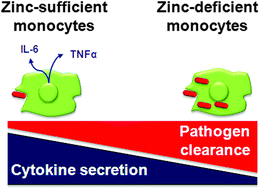Differential impact of zinc deficiency on phagocytosis, oxidative burst, and production of pro-inflammatory cytokines by human monocytes
Abstract
Zinc deficiency has a fundamental influence on the immune defense, with multiple effects on different immune cells, resulting in a major impairment of human health. Monocytes and macrophages are among the immune cells that are most fundamentally affected by zinc, but the impact of zinc on these cells is still far from being completely understood. Therefore, this study investigates the influence of zinc deficiency on monocytes of healthy human donors. Peripheral blood mononuclear cells, which include monocytes, were cultured under zinc deficient conditions for 3 days. This was achieved by two different methods: by application of the membrane permeable chelator N,N,N′,N′-tetrakis-(2-pyridylmethyl)ethylenediamine (TPEN) or by removal of zinc from the culture medium using a CHELEX 100 resin. Subsequently, monocyte functions were analyzed in response to Escherichia coli, Staphylococcus aureus, and Streptococcus pneumoniae. Zinc depletion had differential effects. On the one hand, elimination of bacterial pathogens by phagocytosis and oxidative burst was elevated. On the other hand, the production of the inflammatory cytokines tumor necrosis factor (TNF)-α and interleukin (IL)-6 was reduced. This suggests that monocytes shift from intercellular communication to basic innate defensive functions in response to zinc deficiency. These results were obtained regardless of the method by which zinc deficiency was achieved. However, CHELEX-treated medium strongly augmented cytokine production, independently from its capability for zinc removal. This side-effect severely limits the use of CHELEX for investigating the effects of zinc deficiency on innate immunity.

- This article is part of the themed collection: Zinc in the Biosciences

 Please wait while we load your content...
Please wait while we load your content...